Aeroproducts Propellers
 |
What eventually became the Aeroproducts Propeller Company
had its humble beginnings in 1935 as Engineering Projects, Inc. of Vandalia,
Ohio. It was founded by two brilliant engineers, Werner J. Blanchard, who spent
several years with the Curtiss Electric Propeller Company, and Charles. J. MacNeil.
Engineering Projects was bought by General Motors in 1940 for a speculated price in the $500,000 range and was re-named the Aeroproducts Division of GM. The company delivered only 73 of their novel "Unimatic" Aeroprop propellers in the month of December 1941, rising to 12,500 props in the month of February 1944. The dynamic Charlie MacNeil died from a heart attack in November 1944 at the tender age of 34, while Werner "Pete" Blanchard, age 48, died in the December 1948 crash of his Navion. Aeroproducts evolved to become a Division of Allison in 1952, and eventually the propeller business was sold to Hamilton-Standard in 1990. The type certificate for its most modern propeller now resides with Pacific Propeller. |
Restoring an Aeroproducts Hollow Steel Turbopropeller Blade
The Aeroproducts Models A6441FN-606 and A6441FN-606A Propellers
An Aeroproducts Installation Engineer Remembers
Interviews with Robert Aukerman
by Tom Fey
25 November 2013
 |
Aeroproducts AD86641F-A5
for the Production Douglas A2D (Bob Aukerman) |
The AEHS web site gets about a million hits per month. Last August, one of these hits brought a wonderful surprise in the form of an e-mail from a gentleman named Robert Aukerman regarding a presentation I gave at the 2009 AEHS Convention. It left me dumfounded — or gob smacked as our Brit members might say.
The last aircraft to fly with Aeroproducts contra-rotating propellers were either the Convair Tradewind flying boats (decommissioned 1958) or one of the three Douglas A2D Skysharks bailed to Allison for research after the US Navy cancelled the A2D program in September 1954. Either way, it has been at least 55 years since these propellers have flown, and my hope of ever talking to a pilot or engineer involved in the Aeroproducts contra-rotating propeller program was non-existent. That is until Bob Aukerman, Aeroproducts Installation Engineer on the A2D, sent that e-mail.
A pleasant hour on the phone with Bob provided some interesting stories and insight into the contra-prop program and how aviation development was done in those days. Bob did not pursue engineering but instead planned to teach math and also loaded up with physics and chemistry classes. After two years teaching math and science he passed up a summer job at Wright Field to instead work at Aeroproducts. He started on a drawing board. The company soon needed an installation engineer to support the Douglas A2D program, which used the 1,516 lb., 14 foot diameter, AD8644FN series of propellers coupled to the Allison T40 engine of 5,100 SHP. Bob has described the job of an installation engineer as "a person who is aware of the design purpose, but whose main responsibility is to be certain the product will operate correctly, to intelligently report to the Engineering Department in Dayton, and make headway in flight test. It is a very interesting over-arching position that touches all aspects of development. You meet and advise decision makers yet have a somewhat odd position in the food chain. Not too unlike a paid consultant."
Bob spent six months in training for the position, with much of that time spent in propeller assembly, test cells and hydraulic testing. Later when asked if he wanted to fill an opening in flight testing at Edwards AFB as the propeller installation engineer, the 25 year old Bob Aukerman jumped at the chance. In the next four days, he sold his car, bought another car that would survive the long drive to California, packed everything he owned into the car, and headed west to the Mojave Mecca of flight test.
Arriving at Edwards, the North Base consisted of six hangers, a control tower and the officers club where on one wall were black silhouettes of important officers and test pilots that had passed through Edwards. The notorious Happy Bottom Riding Club, run by famed female aviation pioneer Pancho Barnes, was still open for business a few miles away from Edwards. Bob fondly recalls "I thoroughly enjoyed being at Edwards AFB when so many things were going on. All of the X-Planes of the era were there and most of them flying. The radical X-3 Stiletto was hangared with the XA2D as was the Douglas F4D delta fighter and their heavy two engine A-3 bomber/cargo airplane. Both the B-47 and B-51 medium bombers were flying then. The North American F-100 had arrived and was showing off. A huge B-36 sat on the ramp. A large tandem helicopter was doing autorotation tests nearby. The Aeroproducts supersonic propeller was installed on the XF-84H Thunderjet in another hangar. Everywhere you looked there was something going on. It was a delight for a young fellow to be part of the activity."
The engineer Bob was to replace impressed him with the seriousness of flight testing, training Bob for several weeks on the second prototype Skyshark XA2D-1, 122989, and in the evening walked through complex systems diagrams. Eventually, Bob would troubleshoot similar T40/AD8644FN installations on the Conair R3Y Tradewind and the short-lived North American XA2J-1.
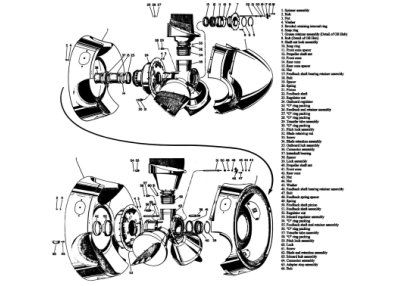 |
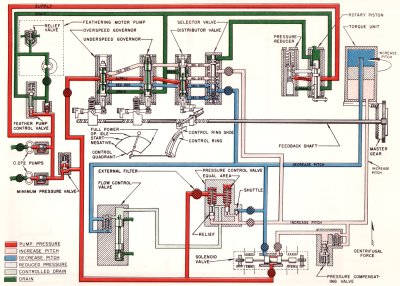 |
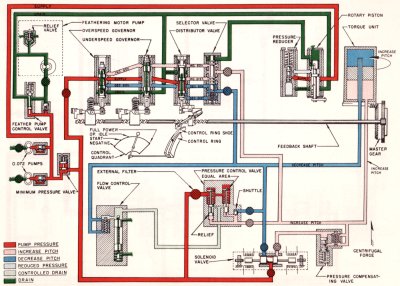 |
Aeroproducts AD866FN Series Contra-Prop
Exploded View Showing Complexity
(Aeroproducts via T. Fey) |
Aeroproducts AD866FN Series Contra-Prop
Electro-Hydraulic Control Circuits — Inboard Overspeed
(Aeroproducts via T. Fey) |
Aeroproducts AD866FN Series Contra-Prop
Electro-Hydraulic Control Circuits — Inboard Underspeed
(Aeroproducts via T. Fey) |
The A2D had a frustrating history. Intended to be a more powerful and capable aircraft to upgrade the attack role performed by the aging R-3350-powered A-1 Skyraider. The Skyshark suffered a prolonged and pain-filled development due in part to the complexity of the T40 turboshaft engine system, the highly stressed gearbox, and the massive 6 blade Aeroproducts contra-rotating propellers. Power plants are Government Furnished Equipment (GFE).The purpose and expectations of the airplane are not always fulfilled with what is furnished under GFE, and coordinating corrections is both slow and difficult. Flexibility of the A2D nose combined with the heavy rotating propellers made for vibration characteristics that were not anticipated and never tamed. The Navy had Allison develop a sea level engine that performed poorly at altitude. The two turbine engines were manually and individually clutched to the gear box with no automatic provision to decouple an engine and its compressor in an emergency. This tragically caused the death of a pilot.
LCDR Hugh Wood USN, attached to the A2D program desk, was flying XA2D-1 Prototype 1 when the starboard engine failed. Instead of feathering the propellers he dove to gain airspeed, crashed and lost his life. The unfeathered propeller system attempted to maintain 100% speed, but was hindered by driving the unpowered compressor which was still connected to the drive train. The functioning engine was unable to provide the power required to maintain prop speed while burdened with driving the non-power producing engine. The drag was tremendous and the airplane wouldn't maintain altitude. The aircraft provision for this problem had been a large feathering button to trigger the propellers to feather. The button was placed in a conspicuous location in the center of the instrument panel. The pilot was expected to feather the propellers to stop windmilling in the event of a power failure. Later test aircraft had the decoupling switches front and center at the top of the instrument panel. Automatic de-couplers were developed in the following months to backup feathering. Later in the program a pilot suspecting a possible problem stopped both engines, feathered the propeller and landed without incident on the lake bed.
The most unusual event in the test program was when C.G. "Doc" Livingston was demonstrating a contract goal in a high speed dive. He had flown the day before but had not reached the design point because of what he felt was a bit of unexpected yaw. This day in a dive, eyes on the instruments, the engine gearbox broke near the front split line and the propeller shaft, along with the entire dual rotation propeller, departed the airplane. Freed of nearly one ton of weight in the extreme nose of the aircraft, the A2D immediately pitched up. The turbine engines were still running, the wind screen was covered with oil and the startled Livingston found there was no part of the airplane in front of him. To his credit he regained control and trimmed the airplane sufficiently to land gear down on the lake bed.
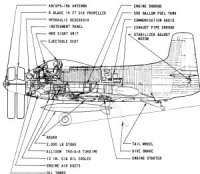 |
Douglas A2D Configuration
(Gerry Margraf A2D Book
via T. Fey) |
There were recurrent engine/gearbox/prop failures which resulted in many emergency landings and at least one ejection. Bob recalls some of the travails of Douglas test pilot George Jansen:
"George was perhaps the one Douglas pilot with the most flight test experience with that airplane since the outset. His reputation for reporting accuracy was unblemished; he was highly respected. Early in the program a T40 gearbox had come apart during ground testing with George in the cockpit, but he was unhurt. You must consider that the pilot sits directly over the engine compressors with his feet literally inches from the gear box. You can’t avoid being highly conscious of the engines just below the seat. By this time, late in the program, George was outspoken in his criticism of the airplane."
Jansen undertook the last test flight of the government program on August 5, 1954. "Officially, George said that a few minutes after take-off he heard something that he felt certain was an impending engine failure and ejected for his safety." Jansen severely injured his back, a valuable test aircraft was lost, and the program terminated on September 7, 1954.
Bob continued: "Eventually, three A2D’s, including the second prototype, XA2D-1 #122989, which I worked on, were flown to Allison from Edwards. Bob LeSeur flew 122989 back to Indianapolis and Bob Aukerman soon followed them back. The color pictures provided by Bob (below) show the aircraft the day before departure, with Bob LeSeur heading out to assure proper fuel transfer from the drop tanks. Aukerman commented that only propeller engineers stand in the plane of the propellers when they are spinning so they can assess blade tips to confirm the blades are set to the proper idle throttle position. When I asked Bob about the noise of the contra-props, he said that the T40/AD8644FN combination was indeed very loud when the airplane was tied down since the blades were essentially stalled while the engine was roaring at high power, 5,000 horsepower compressing air and making heat. He compared the 900 RPM propeller speed making a pounding force similar to that of a big rocket engine. However, when the airplane is flying, the airfoils of the blades are also flying and neither makes much noise unless there is local supersonic flow across the blades. The turbine whine in flight is sometimes louder than the propellers.
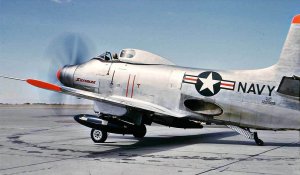 |
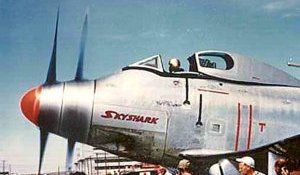 |
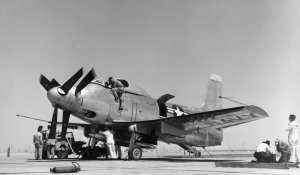 |
 |
| Douglas A2D SN 122989 (Bob Aukerman) |
Douglas A2D SN 122989 (Bob Aukerman) |
Douglas A2D SN 122989 (Bob Aukerman) |
Douglas A2D SN 122989 (Bob Aukerman) |
Looking at the black and white photograph (above), the person on the ladder is Aeroproducts vibration engineer Ed Murray. A careful study of the enlarged photograph (right) shows the both fore and aft blades in the 1 o’clock position as you face the nose of the aircraft are instrumented with strain gauges. Bob commented that the centerline "tank" is actually an instrument pod for collecting the data from the strain gauges. Also of note is the large, square, open door in the fuselage. Bob informed me that a duplicate instrument panel was installed in this space with a 16 mm camera focused on the panel. The pilot would "take a cine" at specific times to document the readings on the various gauges for later analysis of the flight test data.
As for the ultimate cause of the A2D problems, Bob comments that it is very complicated, involving multiple players with multiple agendas that obfuscate a simple explanation. Aukerman was not directly involved in all of the design, engineering, and political decisions of the program, but he did offer a couple of observations. First was perhaps an under estimation of the complexity of mounting remote gearboxes to accommodate all the forces generated by a propeller, particularly at high powers, with large propellers, and in asymmetric flight such as yawing, climbing, or diving. The second was simply that the jet age had arrived and was clearly the future of military aviation, so propeller projects were at a severe funding disadvantage during this time.
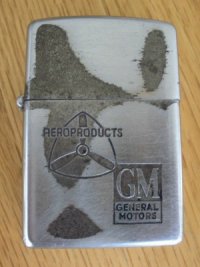 |
Bob spent a total of 10 years with Aeroproducts, including work on Ram Air Turbines (RAT) and the Lockheed Electra program which used the Aeroproducts A6441FN series of 4 blade propellers. Eventually, Bob tired of "being a jet salesman", left Allison, and moved on to Rocketdyne where worked on materials, energy programs, information gathering, strategic planning, and program management. From that point on "Airline reservations were the only connection to aircraft". Bob had an Aeroproducts Zippo lighter for some years, but has since been stolen.
I’d like to thank Bob for taking the time to talk with me and share his "time of fond memories" in flight test. The opportunity to speak with and learn from someone who was there is irreplaceable and greatly appreciated. |
Aeroproducts Zippo Lighter
(Internet via T. Fey) |
The Aeroproducts Propeller
by Tom Fey
The Aeroproducts "Unimatic" constant-speed propeller was an
ingenious, relatively light-weight unit that incorporated the governor, high
pressure oil pump, filter, pressure bypasss valve, and fluid supply in a
donut-shaped assembly on the back of the propeller hub. The only connections to
the airframe were the prop nut and a single steel linkage to control speed. The
Aeroprop could be changed in under 20 minutes, the hollow steel blades were
specifically indexed for hub socket number, and the blades were pre-weighed and
balanced such that one blade could be replaced without disturbing the others
thus no requirement for re-balancing or removal of the prop from the engine. If
the engine lost oil, the Aeroproducts propeller remained fully controllable due
to its independent hydraulic system. Each blade socket had its own hydraulic
actuating torque unit that fit into the hollow butt of the blade shank, and the
bore of the propeller hub was empty, allowing for a cannon barrel, pitot tube,
or radar mount to extend through the hub.
Aeroprops were used as original equipment on a multitude of
piston aircraft, including versions of the P-39 Airacobra, all the P-51K and
P-51H Mustangs, P-63 Kingcobras, P-82 Twin Mustangs, Grumman F8F Bearcats, Douglas AD Skyraiders,
North American T-28A Trojans, the Fairchild C-119, the one-off Lockheed Model 75
"Saturn" and some versions of the Model 18 twin Beechcraft. In more recent times, the homebuilt unlimited air racer
Tsunami used an Aeroprop, as do many of the R-3350 powered Sea Furys.
Aeroproducts manufactured experimental coaxial, contra-rotating units that were
used on the Fisher P-75A Eagle, Boeing XF8B-1, Curtiss XBTC-2, Republic XP-72,
North American A2J-2 Savage, the Convair Tradewind flying boat, and the Douglas A2D Skyshark.
As the turbo-prop era evolved in the late 1950s, the
Aeroproducts hollow-bladed propellers featured self-feathering, reverse pitch,
synchronizing/synchrophasing, and electric de-icing. These units were used on
the Allison T-56 turboshaft powered Lockheed L-188 Electra, Convair 580, Grumman
E2A Hawkeye, and Lockheed C-130A aircraft. The last Aeroproducts propeller unit
was delivered in 1974, and the final blade was plated in the Indianapolis Plant
5 on January 12, 1977, marking the end of Aeroproducts
propeller line.
Construction and Operation
Cutaways
Aeroproducts Propeller
Failure Leading to Convair 340 Accident




















































